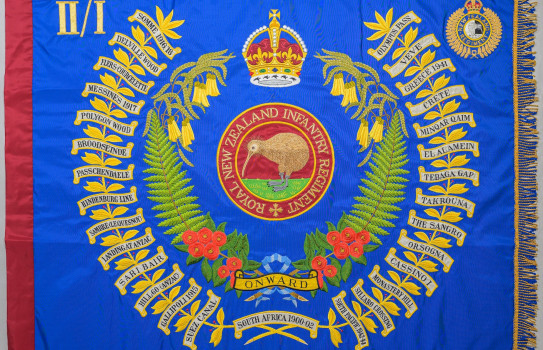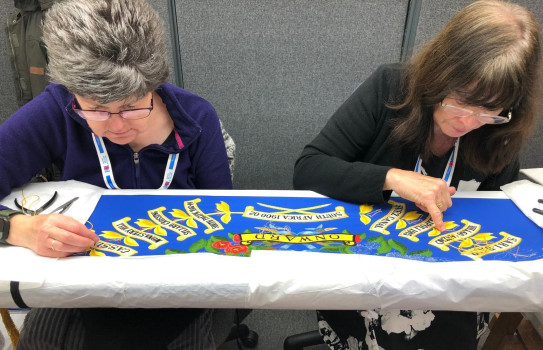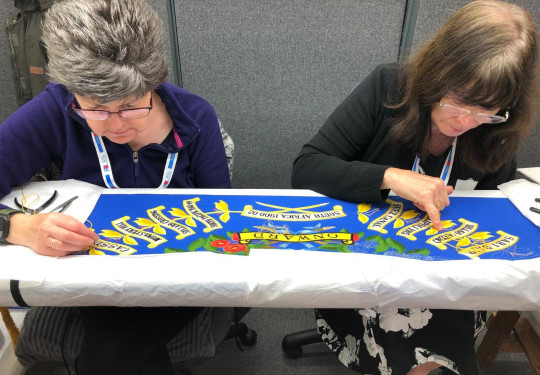Behind the stitch
In a special ceremony last week the new King’s and Regimental Colours of the New Zealand Army’s 2nd/1st Battalion, Royal New Zealand Infantry Regiment (2/1 RNZIR) were consecrated at Burnham Military Camp.
05 November, 2024
They were presented to the Battalion by Her Excellency, The Rt Hon Dame Cindy Kiro, GNZM, QSO, Governor-General of New Zealand, on behalf of His Majesty King Charles III, and marked the culmination of a significant new chapter for 2/1 RNZIR.
The backstory of the Colours (hand-embroidered flags) is also remarkable, and one steeped in history.
2/1 RNIZR’s two new Colours were hand stitched by three women from Wyedean Weaving in the United Kingdom.
Aileen Henderson, Wendy Hatton and Susan Jones collectively have close to 120 years’ experience in perfecting the intricate embroidery of military history around the world.
The three had previously worked with another British weaving company, Hobsons, to supply military embroidery, but when that company ceased trading in 2022 they joined Wyedean Weaving who had then acquired the contract to replace all British Armed Forces’ Colours and Standards.
“We were delighted to accept, bringing our invaluable skills and experience into their fold,” Aileen Henderson, pattern maker said.

The new Regimental Colour of 2nd/1st Battalion, Royal New Zealand Infantry Regiment, emblazoned with eight additional battle honours
Part of Wyedean Weaving’s contract was to update the King’s insignia and Tudor Crown on Colours and Standards, following the King’s ascension in May 2023.
2/1 RNZIR’s Colours are the first in New Zealand to be updated with the King’s insignia.
Ms Henderson said the process of creating the Colours can only begin after the designs have been submitted to the King for approval.
“We can only start production once we receive this approval. I have an exceptional memory for patterns we’d previously created for Hobsons, and can identify if we already have them on file,” Ms Henderson said.
“If we don’t, new patterns are developed. Following the recent change in the monarchy, new patterns have been required to incorporate the King’s crown.”
She said the patterns vary in size depending on their intended use and once a design is scaled to the appropriate size, they are printed and transferred onto vellum (a form of translucent paper).
“The outline of the patterns is pricked with a fine needle to create a stencil, which is then placed on the silk. Depending on the background colour, either black or white ink is used to transpose the design on to the backing material.
“The scrolls are always worked first, followed by the embroidery, starting from the base. The intricate work needed for these particular Colours lasted six months,” she said.
The craftsmanship of 2/1 RNZIR’s new King’s and Regimental Colour took more than 900 hours of meticulous embroidery.
“We utilised three meters of pure silk cloth, 75 grams of gold thread and 150 grams of pure silk embroidery thread,” embroiderer Wendy Hatton said.
The highlight of this project was working with the distinctly different design compared to our usual Colours, particularly the vibrant colours set against the dark blue silk background, which added unique visual appeal.

Susan Jones, left, and Wendy Hatton working on the 2/1 RNZIR Colours in Yorkshire before they were collected and brought back to New Zealand for last week’s ceremony
The new King’s Colour of 2nd/1st Battalion, Royal New Zealand Infantry Regiment
Working on this project carried additional significance for both Ms Hatton and Ms Jones who had previously worked on the embroidery of the Royal New Zealand Air Force’s King’s Colour (although it was called the Queen’s Colour back then) presented in 2019.
“We feel an immense sense of pride and honour in contributing to such significant pieces of history for militaries around the globe,” Ms Jones said.
All three said the pinnacle of their careers was witnessing the consecration of all the King’s Colours for the Coronations of King Charles III and Queen Camilla at Buckingham Palace.
They are all to be awarded Coronation Medals for their precision, passion and professionalism following the hand embroidery of five flags for the King’s Coronation in 2022.
Although colours are no longer carried into battle, they continue to be paraded ceremonially to signify each battalions’ unique history, esprit de corps and identity. For Ngāti Tūmatauenga, the New Zealand Army, these traditions date back to the mid 1800s.
The new King’s and Regimental Colours are the first to be presented to the New Zealand Defence Force during the reign King Charles III, and the first presentation of Colours to any New Zealand infantry battalion since 1997.
Ms Henderson said that Colours typically have a lifespan of 20-25 years depending on their usage.
“For example, the Foot Guards (regular infantry regiments in the Household Division of the British Army) often replace theirs every 15-20 years due to daily use.”
2/1 RNZIR previous King’s and Regimental Colours were presented in 1980 and after more than 44 years of general wear and tear they had reached their lives.
When Colours are replaced they are laid up, which typically sees them hung in a church or chapel associated with the regiment, although some particularly significant Colours may be displayed in cathedrals, or other public buildings such as museums.
“We take great pride in seeing the old Colours laid up in Westminster and other churches, especially when our families ask which ones we created,” Ms Henderson said.
The old 2/1 RNZIR Colours, will be laid up at Burnham’s All Saints Chapel in mid-November.
Read more
Click here(external link)(external link) to dive into the journey of the new King’s and Regimental Colours.
